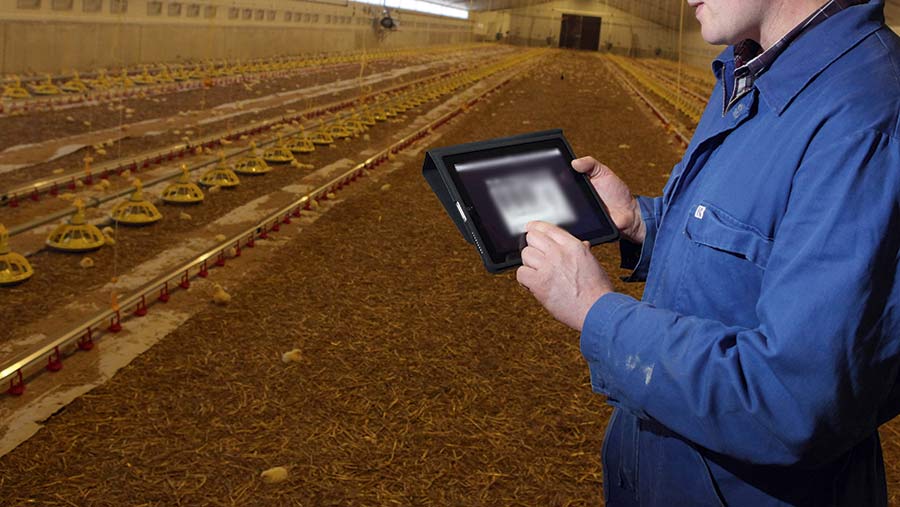How poultry farm data can improve performance
 © Action Press/REX/Shutterstock
© Action Press/REX/Shutterstock There is a great deal to gain from better exploitation of existing information on egg and poultry units, according to one of Europe’s leading experts in the use of data in livestock systems.
“Data is the foundation of better farming, not just for producers but all the players involved,” said Kristof Mertens at last month’s annual meeting of the World Poultry Science Association (WPSA) in Chester.
“We try to make the animals talk to the people that need to know what is going on with them, using modern ICT solutions and big data,” he said.
See also: 3 key ways to improve free-range egg production
As co-founder of Dutch company Porphyrio, his company has developed software systems that automatically collect and analyse the data generated by the computers and the software that “modern poultry farms have already invested in, and have in place”.
The business is associated with Belgium’s University of Leuven, where researchers have spent years analysing data from poultry farms to generate algorithms that offer raw interpretation of existing shed data.
“It is our mission to provide agricultural entrepreneurs with an instrument that they can use to get an edge on the highly competitive market,” said Mr Mertens.
Thanks to automated data collection, it is now possible to gather information in real time on flock health, and instantly inform a farm manager, he said.
However, few modern poultry farms can collate and truly analyse this data because of insufficient time, lack of theoretical knowledge, or other obligations.
Valuable information unused
As a result, valuable information that could provide farmers with insight goes unused.
It is our mission to provide agricultural entrepreneurs with an instrument that they can use to get an edge on the highly competitive market Kristof Mertens, co-founder Porphyrio
This often meant producers missed important warning signs that something was going wrong, which could result in significant damage and loss, he suggested.
“On a technological level, there are a lot of exciting things happening that we as a livestock production sector can adopt, to improve and solve the problems we have.”
There is a vast range of sensor technologies currently available to farmers, and many are still developing, meaning even more data will be in hand in the coming years.
Convenient, affordable data
And with it will come huge opportunities to drive efficiencies through the supply chain, if that data is taken advantage of.
Mr Mertens’ business builds software which collects such information and offers an interpretation based on biological data and analysis of other farms.
It has two products, Lay-Insight, for hens, and Broiler Insight.
“If everything is stored centrally, we can compare it very easily. There’s a lot of power in that.”
The software then presents the data as a dashboard that can be viewed on a smartphone or tablet.
Those dashboards had to be easy to use, said Mr Mertens. It was vital that the user interface had to be fit for everybody, and not just made by engineers for engineers.
“Once the software has analysed the data, production managers receive useful, ready-to-use information on their PC, tablet or smartphone that allows them to immediately act if a problem arises.
“It is not only convenient and immediately ready to use, but is also affordable.
“We are focusing very hard on poultry sector, so we have solutions for egg and meat production.”
The company has adopted the concept of “management by exception”; identifying “where are the problems, where do I need to look?”
The current challenge was embracing all the expertise available in the sector, moving from an animal-centred approach, to a multi-expertise approach.
Digitalising data
Historically, there has been a lot of people, such as feed providers, stock suppliers, vets and other consultants, moving around farms, “drinking coffee”, he said.
The modern farm manager is not be happy with a “casual chat every month” – the future will be ancillary services and expertise the moment it is needed.
“Our goal is to enable collaboration between these parties so that each can bring value back to the complete chain and deliver a solution.”
By starting to collect data in a standardised way, a producer can gain the information required to make more informed choices about the services and supplies they chose to use.
A remaining difficulty is that the sector is still run mainly by pen and paper. There was a lot of information still on farms that posed a challenge.
“Some people are willing to put in data manually, but more recently we have an produced an app where a manager can scan his production sheets and we digitalise them.”
